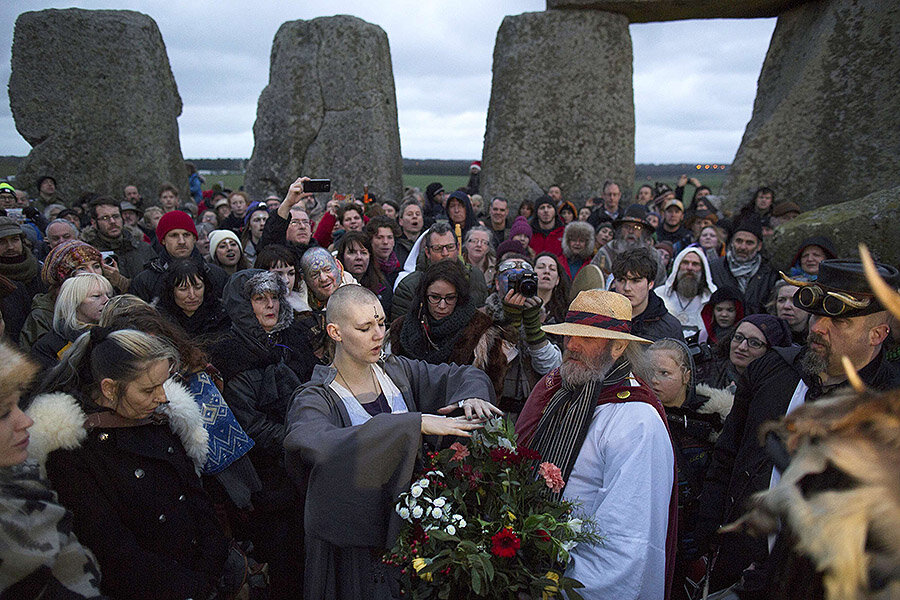Who are those people at Stonehenge celebrating the Winter Solstice?
Loading...
Around 7,000 revelers descended on Stonehenge yesterday evening to welcome the sun on December 22, the Winter Solstice.
"Reveler" is the word typically used by press to describe crowds who flock for a chance to worship the famous megalith on England's Salisbury Plain, or enjoy a rare chance to touch the stones. Tens of thousands more might come, if modern problems like parking didn't limit attendance.
But who's at the party?
While the Winter and Summer Solstices draw all sorts, the legendary stones belong to the Druids, past and present, in popular imagination. (Less romantically, they actually belong to English Heritage, a charity that manages 400 historic sites around the country.)
Yet despite a thriving revivalist movement, no one quite knows who the "original" Druids were, or even where they lived. In Britain and Ireland, where ancient Druid culture is associated with the Celts, Druid history was entirely oral, meaning that all written references are secondhand, at best – and usually coming from Romans or early Christian sources, who were hardly interested in portraying the Druids in a positive light.
The popular image that's trickled down from those first few sources seems to have stuck. First-century historian Tacitus, who it's safe to say was not an eyewitness, described the Druids as mysterious and powerful:
All round, the druids, lifting up their hands to heaven, and pouring fourth dreadful imprecations, scared our soldiers by the unfamiliar sight, so that, as if their limbs were paralysed, they stood motionless, and exposed to wounds.
Many historians say the Druids were an upper-crust of Celtic society: a highly-trained class of men and women who may have advised kings and been teachers or spiritual leaders – although, as scholar Barry Cunliffe told LiveScience, ancient texts don't exactly call them "priests."
Whoever they were, the spread of Christianity signaled their demise over a millennium ago. But now, some say, those roles are reversing.
By the late 1700s, interest in Druid heritage was on the rise. But those first revivalists were more hungry for Druid culture than Druid spirituality; most of them, according to Ancient Order of Druids in America member and author John Michael Greer, considered themselves Christian.
That began to change in the 1960s, as multiple groups identifying themselves as Druids pieced together a new tradition. Some say increasing concern over environmental change has helped to drive people towards a philosophy, faith, or lifestyle – adherents' own definitions vary – that they associated with nature. Others think the decreasing influence of mainstream religion is helping open minds to different traditions, and convincing them that what matters is what Druidry does for people today, not knowing every detail of its history.
"I think people are looking to their roots and looking back at the secular world certain that things don't work," Arthur Pendragon, a Senior Druid and a regular fixture at the Solstices, told the BBC in 2010. That's the year Druidry got a public boost, earning official recognition as a religion from the United Kingdom's Charity Commission. To qualify, a Druid organization had to prove it had "coherent practices for the worship of a supreme being, and provided a beneficial moral framework."
But "coherence" is not always the right word to describe diverse Druid groups, beliefs, and practices (nor most world religions). Some Druids say they're monotheists, others polytheists; some members take a more relaxed approach, while others are intent on training in healing or magic.
Despite being a symbol of ancient Druidry, Stonehenge's connection is unclear. Theories about the stones' origin and purpose seem to change on a monthly basis, but it's possible they predate Druid culture, which was first written about around 2,400 years ago. But its stones do seem perfectly positioned to frame the Solstice sunset, at the close of the shortest day of the year, and archaeological evidence suggests that somebody was feasting mid-winter in the megalith's early days.
As is true in cultures all over the world, the turn of the year is a time to enjoy the harvest and look for signs that spring may be around the corner.
"This is the dawn we've been waiting for, this is the dawn the ancients cared about so much," Mr. Pendragon told the BBC this year. "After this they knew the days were going to get longer and the return of hope and renewal."
No coincidence that many of another late-December festival's symbols come from similar pagan traditions: Christmas trees and Yule logs are traced to pre-Christian cultures, as well.
The Solstice "reminds us that all things are temporary, particularly things that are difficult," Wiccan priestess Courtney Weber told the Huffington Post. "If we embody the soul of Yule or winter solstice throughout the year, we can remember that even when the night is at its longest, the dawn is coming."
But at Stonehenge today, as in Druidry worldwide, a diverse array of beliefs, practices, and even attire didn't prevent "revelers" from sharing one thing.
"The energy here is unbelievable," one visitor told the Guardian at the 2012 event.






